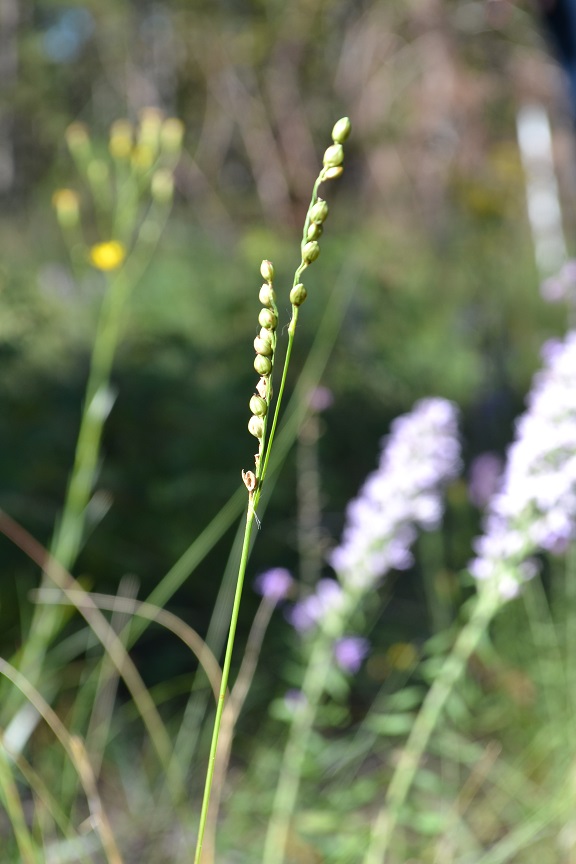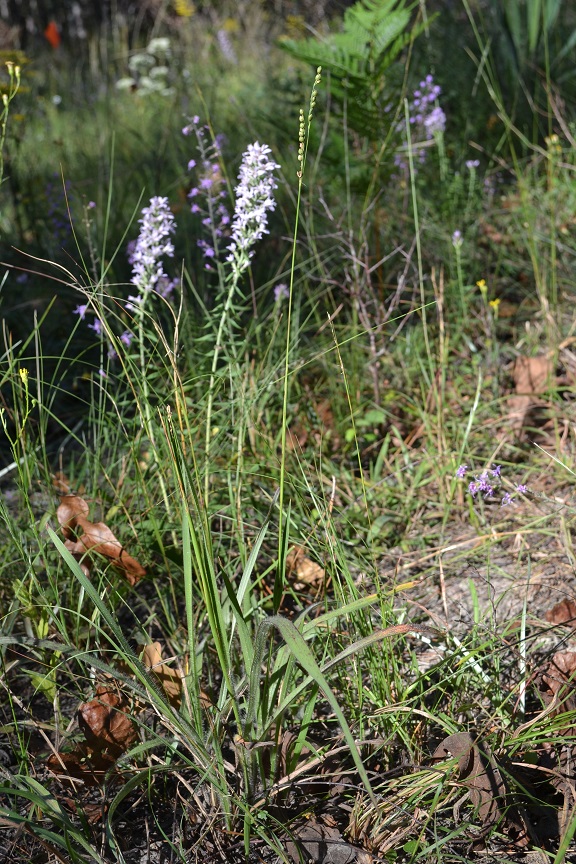Paspalum bifidum
| Paspalum bifidum | |
|---|---|

| |
| Photo taken by Kevin Robertson | |
| Scientific classification | |
| Kingdom: | Plantae |
| Division: | Magnoliophyta - Flowering plants |
| Class: | Liliopsida – Monocotyledons |
| Order: | Cyperales |
| Family: | Poaceae ⁄ Gramineae |
| Genus: | Paspalum |
| Species: | P. bifidum |
| Binomial name | |
| Paspalum bifidum (Bertol.) Nash | |

| |
| Natural range of Paspalum bifidum from USDA NRCS Plants Database. | |
Common name: pitchfork paspalum, pitchfork crown grass[1]
Contents
Taxonomic notes
Synonyms: none.[1]
Varieties: none.[1]
Description
"Annuals or perennials. Leaves primarily basal and low cauline; blade margins usually scaberulous; ligules membranous. Spikelets plano-convex, terminal floret fertile, basal floret sterile. Frist glume usually absent, sterile lemma resembles 2nd glume; fertile lemma and paleas indurate, lustrous, yellowish or brownish. These plants are all important forage grasses."[2]
"Perennial form thick rhizome; culms 6-9 dm tall, nodes glabrous or appressed pubescent, internodes glabrous. Blades to 20 cm long, 3-15 mm wide, papillose-pilose to almost glabrous, margins usually ciliate; ligules 2-2.5 mm long. Racemes usually 3, racemose, ascending, 4-9 cm long; rachis triangular, wingless, scaberulous. Spikelets broadly ellipsoid, 3.5-3.8 mm long, basically in 4 rows but by abortion in 2 or 1; pedicels scaberulous angled, 1-3 mm long. Frist legume reduced, rounded, 0.25-0.5 mm long, 2nd glume 7-9 nerved, yellowish brown, glabrous, obtuse, 2.5-3.5 mm long, sterile lemma 5-nerved, yellowish brown, glabrous, obtuse, 3.5-3.8 mm long; fertile lemma and palea lemma nerveless, obtuse, 3.5-3.8 mm long. Grain purplish, broadly ellipsoid, 3 mm long."[2]
Distribution
This plant ranges from southeast Virginia to southern Florida, then west to southeast Missouri, southeast Oklahoma, and eastern Texas.[1]
Ecology
Habitat
This species can be found growing in longleaf pine-scrub oak sand ridges, sandhills, mixed woodlands, and open longleaf pine forests on rolling terrain.[3] It has been observed in dry loamy sands and moist hummus-rich soils in open areas.[3] P. bifidum can also grow in disturbed areas such as along dirt roads and bottomland clearings along rivers.[3] Associated species include longleaf pine, palmetto, wiregrass, Liatris elegans, Quercus laevis, Hypericum gentianoides, Trichostema setacea, Cassia fascicularis, Eupatorium hyssopifolium, Liatris graminifolia, Elephantopus elatus, Agaratina aromatica, and Helianthus angustifolius.[3]
Phenology
This species flowers from August to October.[3]
Seed dispersal
This species is thought to be dispersed by gravity.[4]
Fire ecology
Populations of Paspalum bifidum have been known to persist through repeated annual burns.[5][6]
Conservation, cultivation, and restoration
Cultural use
Photo Gallery
References and notes
- ↑ 1.0 1.1 1.2 1.3 Weakley, A.S. 2020. Flora of the Southeastern United States. Edition of 20 October 2020. University of North Carolina at Chapel Hill, Chapel Hill, North Carolina. Cite error: Invalid
<ref>tag; name "weakley" defined multiple times with different content Cite error: Invalid<ref>tag; name "weakley" defined multiple times with different content Cite error: Invalid<ref>tag; name "weakley" defined multiple times with different content - ↑ 2.0 2.1 Radford, Albert E., Harry E. Ahles, and C. Ritchie Bell. Manual of the Vascular Flora of the Carolinas. 1964, 1968. The University of North Carolina Press. 132-5. Print.
- ↑ 3.0 3.1 3.2 3.3 3.4 Florida State University Robert K. Godfrey Herbarium database. URL: http://herbarium.bio.fsu.edu. Last accessed: June 2014. Collectors: Loran C. Anderson, Robert K. Godfrey, James R. Burkhalter, Bob Lazor,G. Knight, M. Davis, and Robert L. Lazor. States and Counties: Florida: Bay, Escambia, Jackson, Leon, Liberty, Taylor, Wakulla, and Washington. Georgia: Baker and Thomas.
- ↑ Kirkman, L. Katherine. Unpublished database of seed dispersal mode of plants found in Coastal Plain longleaf pine-grasslands of the Jones Ecological Research Center, Georgia.
- ↑ Robertson, K.M. Unpublished data collected from Pebble Hill Fire Plots, Pebble Hill Plantation, Thomasville, Georgia.
- ↑ Platt, W.J., R. Carter, G. Nelson, W. Baker, S. Hermann, J. Kane, L. Anderson, M. Smith, K. Robertson. 2021. Unpublished species list of Wade Tract old-growth longleaf pine savanna, Thomasville, Georgia.
